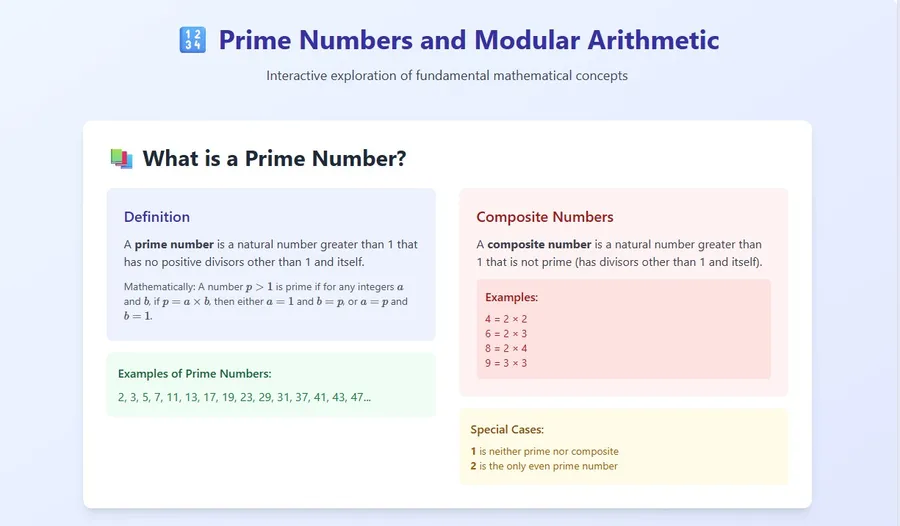Learn about prime numbers: definitions, properties, examples, and real-life applications in math and cryptography.
Table Of Contents
Prime Numbers: Definition, Properties, and Their Role in Mathematics
1. Introduction
Prime numbers are one of the fundamental topics in number theory and form the basis for many branches of modern mathematics, from computer algorithms to cybersecurity (cryptography).
For high school students, understanding prime numbers is not only important for exams, but also serves as a gateway to deeper mathematical concepts.
Simple definition: A prime number is a positive integer that has exactly two distinct factors, namely 1 and itself.
2. Formal Definition
Formally, a number is called a prime number if:
- is a positive integer ()
- The only positive factors of are and itself.
Notation:
3. Examples and Non-Examples of Prime Numbers
- Prime numbers: 2, 3, 5, 7, 11, 13, 17, 19, 23, 29, …
- Not prime numbers:
- 1 (has only one factor)
- 4 (has factors 1, 2, and 4)
- 9 (has factors 1, 3, and 9)
- 15 (has factors 1, 3, 5, 15)
4. Important Properties of Prime Numbers
- 2 is the only even prime number.
All even numbers > 2 are divisible by 2. - Every integer > 1 can be factored into prime numbers. (Fundamental Theorem of Arithmetic)
- There are infinitely many prime numbers. (Proof by Euclid)
- The difference between prime numbers is not always constant, but there are pairs of primes with a difference of 2 (called twin primes), such as (3, 5) or (11, 13).
- The distribution of prime numbers becomes sparser as numbers get larger, but there are still infinitely many.
5. Why Are Prime Numbers Important?
- Number Theory: The foundation for understanding factorization, GCD/LCM, and Diophantine equations.
- Cryptography: Modern encryption algorithms (RSA) use large prime numbers for data security.
- Computer Science: Used in hashing, random number generation, and error detection.
- Pure Mathematics: Appear in various theorems such as Wilson’s Theorem, Dirichlet’s Theorem, and the Goldbach Conjecture.
6. Common Mistakes in Understanding Prime Numbers
- Thinking 1 is a prime number.
The modern definition excludes 1 from primes because it has only one factor. - Assuming large numbers are not prime.
There are very large prime numbers, even with hundreds of millions of digits. - Relying on manual division tests for all numbers.
There are efficient methods like the Sieve of Eratosthenes and the Miller-Rabin Test.
7. Example Problems and Solutions
Problem 1
Determine whether 97 is a prime number.
Solution:
- Prime numbers greater than 2 must be odd.
- Check divisors up to , so check 2, 3, 5, 7.
- 97 is not divisible by 2, 3, 5, or 7.
- Therefore, 97 is a prime number.
Problem 2
List all prime numbers between 50 and 70.
Solution:
The numbers are: 53, 59, 61, 67.
Problem 3
Factor 504 into its prime factors.
Solution:
8. Independent Exercises
- List all prime numbers between 100 and 120.
- Factor 840 into its prime factors.
- Is 101 a prime number? Explain.
Short Answer Key:
- 101, 103, 107, 109, 113
- Yes, because it has no factors other than 1 and 101.
9. Interesting Facts about Prime Numbers
- The largest known prime number (as of 2024) has more than 25 million digits.
- There are twin primes such as (17, 19).
- Prime numbers are used in random number generation in computers.
10. Conclusion
Understanding prime numbers is an important first step to mastering number theory and modular arithmetic. From basic introduction to real-world applications like data security, prime numbers show that mathematics is not just about numbers, but also about the patterns and structures that form the foundation of modern technology.
📚 See also: Prime Factorization – Definition, Methods, and Example Problems↝
📚 Related: Theorem of Multiples of 3: Rules, Proof, and Examples↝
📌 Study Tips:
- Practice testing the primality of small numbers without a calculator.
- Learn quick methods like the Sieve of Eratosthenes.
- Try online applications to find large prime numbers.
